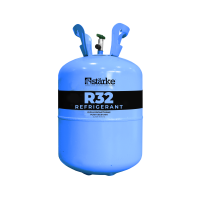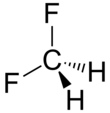This is the current revision of this page, as edited by Dpieski (talk | contribs) at 17:30, 21 November 2024 (Arranged based on text reference). The present address (URL) is a permanent link to this version.
Revision as of 17:30, 21 November 2024 by Dpieski (talk | contribs) (Arranged based on text reference)(diff) ← Previous revision | Latest revision (diff) | Newer revision → (diff)
| |||
| Names | |||
|---|---|---|---|
| Preferred IUPAC name Difluoromethane | |||
| Other names
Carbon fluoride hydride Methylene difluoride | |||
| Identifiers | |||
| CAS Number | |||
| 3D model (JSmol) | |||
| Abbreviations | HFC-32 R-32 | ||
| Beilstein Reference | 1730795 | ||
| ChEBI | |||
| ChEMBL | |||
| ChemSpider | |||
| ECHA InfoCard | 100.000.764 | ||
| EC Number |
| ||
| Gmelin Reference | 259463 | ||
| MeSH | Difluoromethane | ||
| PubChem CID | |||
| RTECS number |
| ||
| UNII | |||
| UN number | 3252 | ||
| CompTox Dashboard (EPA) | |||
InChI
| |||
SMILES
| |||
| Properties | |||
| Chemical formula | CH2F2 | ||
| Molar mass | 52.024 g·mol | ||
| Appearance | Colourless gas | ||
| Density | 1.1 g cm(in liquid form) | ||
| Melting point | −136 °C (−213 °F; 137 K) | ||
| Boiling point | −52 °C (−62 °F; 221 K) | ||
| log P | -0.611 | ||
| Vapor pressure | 1,518.92 kPa (220.301 psi) (at 21.1 °C ) | ||
| Hazards | |||
| GHS labelling: | |||
| Pictograms | 
| ||
| Signal word | Danger | ||
| Hazard statements | H220 | ||
| Precautionary statements | P210, P377, P381, P403, P410+P403 | ||
| NFPA 704 (fire diamond) |
 | ||
| Autoignition temperature |
648 °C (1,198 °F; 921 K) | ||
| Safety data sheet (SDS) | MSDS at Oxford University | ||
| Except where otherwise noted, data are given for materials in their standard state (at 25 °C , 100 kPa).
| |||
Difluoromethane, also called difluoromethylene, HFC-32 Methylene Fluoride or R-32, is an organic compound of the dihalogenoalkane variety. Invented in 1964 by Hoechst AG (not Daikin) it has the formula of CH2F2. It is a colorless gas in the ambient atmosphere and is slightly soluble in water, with a high thermal stability. Due to the low melting and boiling point, (−136.0 and −51.6 °C respectively) contact with this compound may result in frostbite. In the United States, the Clean Air Act Section 111 on Volatile Organic Compounds (VOC) has listed difluoromethane as an exception (since 1997) from the definition of VOC due to its low production of tropospheric ozone. Difluoromethane is commonly used in endothermic processes such as refrigeration or air conditioning.
Further information: Difluoromethane (data page)
Synthesis
Difluoromethane is primarily synthesized via batch processes, by the reaction of dichloromethane and hydrogen fluoride (HF), in the liquid phase using SbCl5 as a catalyst. Due to hydrogen fluoride's hazardous properties, a new process (based on the same reaction) was developed. The new process allows for constant flow of difluoromethane production through an isolated chamber.
Applications

Difluoromethane is often used as a fire extinguishant due to its ability to undergo endothermic processes. Atmospheric concentration of difluoromethane at various latitudes since the year 2009 are shown to the left.

Difluoromethane is a molecule used as refrigerant that has prominent heat transfer and pressure drop performance, both in condensation and vaporization. It has a 100-year global warming potential (GWP) of 675 times that of carbon dioxide, and an atmospheric lifetime of nearly 5 years. It is classified as A2L - slightly flammable by ASHRAE, and has zero ozone depletion potential (ODP). Difluoromethane is thus a relatively low-risk choice among HFC refrigerants, most of which have higher GWP and longer persistence when leaks occur.
The common refrigerant R-410A is a zeotropic, 50/50-mass-percent mixture of difluoromethane and pentafluoroethane (R-125). Pentafluoroethane is a common replacement for various chlorofluorocarbons (i.e Freon) in new refrigerant systems, especially for air-conditioning. The zeotropic mix of difluoromethane with pentafluoroethane (R-125) and tetrafluoroethane (R-134a) is known as R-407A through R-407F depending on the composition. Likewise, R-504 is the azeotropic (48.2/51.8 mass%) mixture of difluoromethane and chlorotrifluoromethane (R13). In 2011 17,949,893 metric tons of difluoromethane were emitted into the atmosphere in the United States alone.
Difluoromethane is currently used by itself in residential and commercial air-conditioners in Japan, China, and India as a substitute for R-410A. In order to reduce the residual risk associated with its mild flammability, this molecule should be applied in heat transfer equipment with low refrigerant charge such as brazed plate heat exchangers (BPHE), or shell and tube heat exchangers and tube and plate heat exchangers with tube of small diameter. Many applications confirmed that difluoromethane exhibits heat transfer coefficients higher than those of R-410A under the same operating conditions but also higher frictional pressure drops.
Other uses of difluoromethane include its use as aerosol propellants, blowing agents, and solvents.
Environmental effects
Every year, approximately 15 kilotonnes of difluoromethane are produced. In gas form, the compound will degrade in the atmosphere by reaction with photochemically-produced hydroxyl radicals. This process will form carbonyl difluoride. The half-life for this process is estimated to be 4 years. Difluoromethane tends to enter the environment via the gas phase and accumulates there more commonly than in soils or sediments. Volatilization half-lives of this compound are about 45 minutes for rivers and 69 hours for lakes, difluoromethane does not bioaccumulate in aquatic areas well.
HFC-32 released into the environment gets broken down into CF as an intermediate product. This goes on to create HF and CO2 by hydrolysis in atmospheric water.
The global warming potential (GWP) of HFC-32 is estimated at 677 on a 100-year time window. This is far lower than the GWP for HFC refrigerants it is replacing, but remains sufficiently high to spur continued research into using lower-GWP refrigerants.
Difluoromethane is excluded from the list of VOCs supplied in the United States Clean Air Act due to the ODP being zero. Therefore, tropospheric ozone is not likely to be produced from this molecule. Tropospheric ozone may lead to adverse health effects such as respiratory, cardiac or neurological damage. Additionally, ozone can affect plant and vegetation by inducing the bronzing of leaves.
Toxicity
Difluoromethane shows slight maternal and developmental toxicity at concentrations of approximately 50,000 ppm in rats, but not in rabbits. The exposure limitations set on difluoromethane for human use are 1,000 ppm, making exposure to dangerous levels unlikely.
References
- "Difluoromethane - Compound Summary". The PubChem Project. US: National Center of Biotechnological Information.
- ^ "Editorial Board". Journal of Fluorine Chemistry. 241: 109706. January 2021. doi:10.1016/s0022-1139(20)30404-8. ISSN 0022-1139. S2CID 243320092.
- ^ "Stratospheric Ozone Protection: The Montreal Protocol and Title VI of the Clean Air Act Amendments of 1990". Air & Waste. 43 (8): 1066–1067. August 1993. doi:10.1080/1073161x.1993.10467184. ISSN 1073-161X.
- ^ Shen, Tao; Ge, Xin; Zhao, Hengjun; Xu, Zhixiong; Tong, Shaofeng; Zhou, Shaodong; Qian, Chao; Chen, Xinzhi (2020-07-01). "A safe and efficient process for the preparation of difluoromethane in continuous flow". Chinese Journal of Chemical Engineering. 28 (7): 1860–1865. doi:10.1016/j.cjche.2020.02.024. ISSN 1004-9541. S2CID 216394634.
- Blowers, Paul; Hollingshead, Kyle (2009-05-21). "Estimations of Global Warming Potentials from Computational Chemistry Calculations for CH 2 F 2 and Other Fluorinated Methyl Species Verified by Comparison to Experiment". The Journal of Physical Chemistry A. 113 (20): 5942–5950. Bibcode:2009JPCA..113.5942B. doi:10.1021/jp8114918. ISSN 1089-5639. PMID 19402663.
- Longo, Giovanni A.; Mancin, Simone; Righetti, Giulia; Zilio, Claudio (2015). "HFC32 vaporisation inside a Brazed Plate Heat Exchanger (BPHE): Experimental measurements and IR thermography analysis". International Journal of Refrigeration. 57: 77–86. doi:10.1016/j.ijrefrig.2015.04.017.
- May 2010 TEAP XXI/9 Task Force Report
- 2009 ASHRAE Handbook
- "R32".
- Galka, Michael D.; Lownsbury, James M.; Blowers, Paul (2012-12-04). "Greenhouse Gas Emissions for Refrigerant Choices in Room Air Conditioner Units". Environmental Science & Technology. 46 (23): 12977–12985. Bibcode:2012EnST...4612977G. doi:10.1021/es302338s. ISSN 0013-936X. PMID 23136858.
- ^ Longo, Giovanni A.; Mancin, Simone; Righetti, Giulia; Zilio, Claudio (2016). "HFC32 and HFC410A flow boiling inside a 4 mm horizontal smooth tube". International Journal of Refrigeration. 61: 12–22. doi:10.1016/j.ijrefrig.2015.09.002.
- IPCC AR4, summarized at https://www.ghgprotocol.org/sites/default/files/ghgp/Global-Warming-Potential-Values%20%28Feb%2016%202016%29_1.pdf
See also
- R-410A, a refrigerant that is being phased out, and which R-32 is a popular replacement for
- R-454B, another R-410A replacement
- List of refrigerants
External links
- Flammability Measurements of Difluoromethane in Air at 100 °C Archived 2016-09-20 at the Wayback Machine
- Difluoromethane at Gas Encyclopaedia Archived 2016-03-03 at the Wayback Machine
- IR absorption spectra Archived 2006-10-13 at the Wayback Machine
- SDS Data sheet
| Halomethanes | |
|---|---|
| Unsubstituted | |
| Monosubstituted | |
| Disubstituted | |
| Trisubstituted | |
| Tetrasubstituted | |
| * Chiral compound. | |

